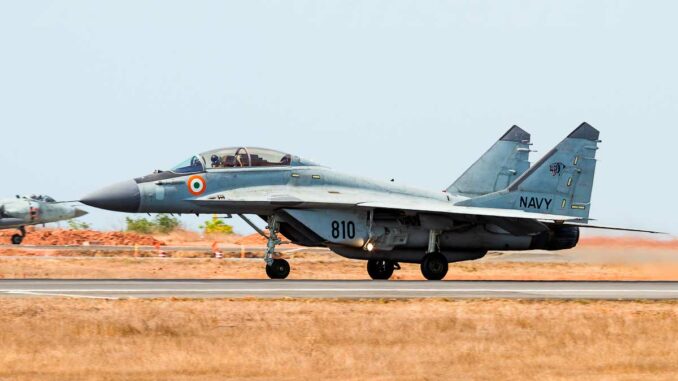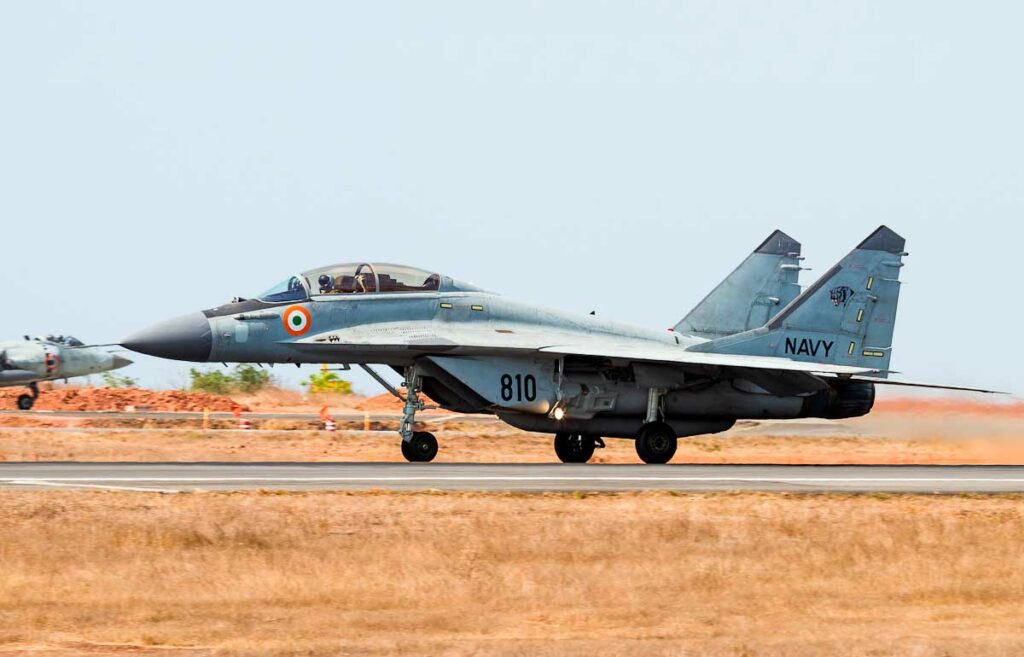
A leak has disclosed Russian reports on the failures of the Zhuk-ME radar in the Indian Navy’s MiG-29Ks: reliability well below contractual expectations.
Summary
Internal documents exposed by the Black Mirror hacker group reveal the persistent difficulties of the Zhuk-ME radar installed on the Indian Navy’s MiG-29K / KUB. The report—taken from Rostec’s archives—details that the radar does not meet the reliability levels stipulated in the 2004 contract with RAC MiG: the MTBF was to reach 150 flight hours, and the MTBD 120 hours. In reality, data from 2016-2018 shows much lower performance: as early as 2016, the MTBD was only 20 hours and the MTBF was 97 hours. By 2017, the MTBF had fallen to 60 hours. Leaks also reveal that some of the flight hours used in the calculations came from simulated modules, artificially inflating the figures. Faced with pressure from India, Russian engineers attempted revisions and replacements, but the financing burden remained unresolved. In 2019, the Indian Navy reportedly declassified the Zhuk-ME from its original equipment manufacturer certificate, signaling the breaking point in the technical relationship between New Delhi and Moscow.
The context of the Indian MiG-29K/KUB program
The genesis and ambitions
The Indian Navy had acquired MiG-29K/KUBs to equip its aircraft carriers with a modern carrier-based fighter. The model was supposed to provide naval air superiority, battle group defense, and multi-role missions from the INS Vikramaditya. The radar installed, the Zhuk-ME, an export version of the Russian Zhuk radar, was chosen for its promised air and sea detection capabilities.
The contract signed in 2004 with the Russian firm RAC MiG included strict technical guarantees: the radar had to achieve an MTBF (Mean Time Between Failures) of at least 150 hours and an MTBD (Mean Time Between Defects) of 120 hours. These parameters help to measure robustness and continuity of operation under operational conditions.
MiG-29Ks in the Indian fleet
The MiG-29Ks are based at INS Hansa, the naval air base in Goa. They also operate from the flight deck of INS Vikramaditya. The navalization of the fighter involves increased constraints: salt corrosion, rough landing, strong structural vibrations, and the need for redundancy in critical systems such as radar. These constraints reinforce the challenge of reliability for onboard equipment.
The content of the leak: figures and failures
The leak and its origins
The leaked document, called ” Report on the Reliability and Performance of the Zhuk-ME Radar in MiG-29K/KUB Aircraft of the Indian Navy,” comes from sources close to Rostec, the Russian defense conglomerate. It likely originated from a targeted hack and exposes exchanges between Russian authorities, Rac MiG engineers, and Indian officials.
According to the leak, internal discussions have been ongoing for several years to address recurring failures, repair delays, and unfulfilled contractual obligations. In particular, the document alleges that some flight hours recorded for reliability corresponded to flights with dummy modules, intended to mask the actual weakness of the system.
Actual performance observed
Data compiled between 2016 and 2018 at Russian-Indian conferences at INS Hansa show a striking discrepancy with the contract:
- At the beginning of 2016, the MTBD mentioned was 20 hours, and the MTBF was 97 hours.
- By mid-2017, the MTBF had fallen to 60 hours.
- Russian engineers had attempted upgrades and block replacements, but without restoring reliability in the long term.
- Internal sources indicate that the true performance indicator (excluding dummy modules) differed significantly from the official figures.
Indian memos included in the file refer to unsatisfactory performance, repeated radar failures, and excessive repair times.
The decommissioning of the radar
A notable point: in May 2019, the Indian Navy officially removed the Zhuk-ME from its Original Manufacturer Certificate. This administrative gesture reflects the formal rejection of the radar as a certified component for the MiG-29K / KUB. In other words, despite being installed, the radar was no longer considered reliable or acceptable according to naval standards.

Technical, operational, and contractual implications
A critical point for combat capability
The radar is the heart of the air mission system: it guides air-to-air engagements, maritime detection, navigation, and data fusion. If the radar suffers frequent failures, the aircraft loses its tactical autonomy and its ability to conduct air defense missions becomes limited.
For the Indian Navy, this weakens its naval deterrence posture in the Indian Ocean, particularly in the context of regional rivalry with China. Some MiG-29Ks may be grounded more often than they are useful due to radar unavailability.
Tensions in Russia-India relations
The document reveals significant pressure from India on Russia to demand repairs or redesigns at Russia’s expense. However, the leak indicates that Rostec/Rac MiG demanded that India pay for certain upgrades or modifications, a negotiation considered unacceptable by the Indians.
These tensions are part of a broader context: for several years, India has been considering diversifying its defense suppliers and strengthening its national sovereignty. This type of technical dispute weakens the image of Russian-Indian cooperation.
The cost of unreliability
Frequent breakdowns result in high costs for maintenance, spare parts, logistics, and aircraft downtime. They reduce the serviceability rate of the MiG-29K fleet. In previous audits, India’s CAG (Comptroller and Auditor General) had already criticized the low availability rate of the MiG-29Ks, with some reports indicating availability of around 37 to 70%.
Thus, faulty radars exacerbate an existing vulnerability. Delays or failure to replace the radar directly impact the operational effectiveness of the naval fleet.
The technical dimensions of the Zhuk-ME and its limitations
The Zhuk-ME: characteristics and expectations
The Zhuk-ME radar is designed as a maritime/export version of the Zhuk-M radar, with mapping, naval detection, and multi-target tracking capabilities. It weighs approximately 220 kg according to sources, and is advertised as being able to detect airborne targets at a range of around 120 km with a radar cross-section of 5 m². In its original version, it was designed to track up to ten targets and engage four simultaneously.
For naval missions, it must also detect ships, small maritime targets, and coastal targets. The radar has an azimuth scan of ±85° and an elevation scan of +56° / –40°, according to the MiG-29K technical documents.
Exacerbated naval challenges
Operating from an aircraft carrier subjects the radar to extreme vibrations, mechanical stresses, saline conditions, frequent thermal cycles, and structural modifications. These constraints require increased radar robustness and rigorous maintenance.
Failures can occur in the traveling wave tubes (TWT), high-voltage power supplies, electronic control system, cooling components, or mechanical rotation elements. A single failure in any of these subassemblies renders the radar unusable.
The frequency of failures suggested by the leak (very low MTBF) indicates that the modules did not have a sufficient lifespan or limited hardware redundancy.
Reactions, credibility of the leak, and possible remedies
Validity of the documents and unofficial reactions
The leak comes from the Black Mirror group, which has already carried out several intrusions into Russian defense companies. The fact that the documents bear internal signatures and cite Indian memos lends credibility to the content, but Russia or Rac MiG may contest the version or contextualization of the excerpts.
No major public confirmation has yet been received from the Russian authorities at the time of writing. Denials or mitigated versions can be expected. However, the volume of technical details and the consistency of the figures (MTBF, MTBD) reinforce the thesis of an authentic report.
Possible avenues for redress
Several avenues are open to redress the situation:
- Re-engineering of the radar by Phazotron/KRET: module repairs, HV redesigns, replacement of TWT tubes, or switch to modernized modules. The document indicates that some modifications have already been undertaken.
- Strengthening of the Indian contract: requiring performance guarantees, penalty clauses, or redesigns at Russia’s expense.
- Replacement with an alternative radar: if the Zhuk-ME remains unstable, India could consider developing or adopting a third-party radar (Indian or Western AESA) for its MiG-29Ks.
- Intensification of quality control and predictive maintenance: use of on-board diagnostics, module rotation, rapid fault reporting, and preventive replacement.
This leak sheds a harsh light on the flaws in a critical system that is supposed to guarantee the performance of a strategic carrier-based fighter. The gap between contractual promises and operational reality is enormous. If the Indian Navy continues to operate MiG-29Ks with unreliable radars, the strategic threat will be diminished.
The credibility of Russian defense as a supplier of key systems is also being tested. India could accelerate its technological diversification, move away from Russian dependencies, and invest in a national radar industry.
If these revelations prompt New Delhi to impose a radical overhaul of technical support or to re-qualify its MiG-29Ks, they could mark a turning point in Russian-Indian defense cooperation.
War Wings Daily is an independant magazine.